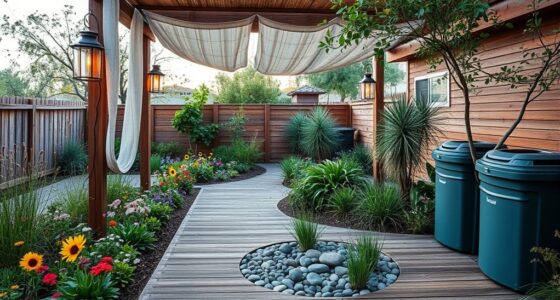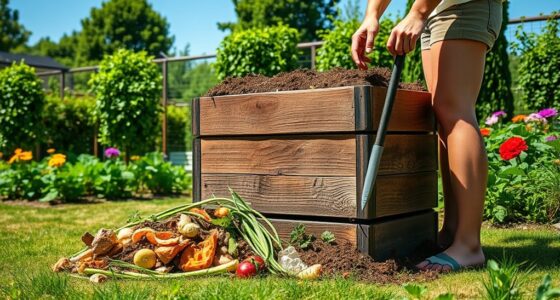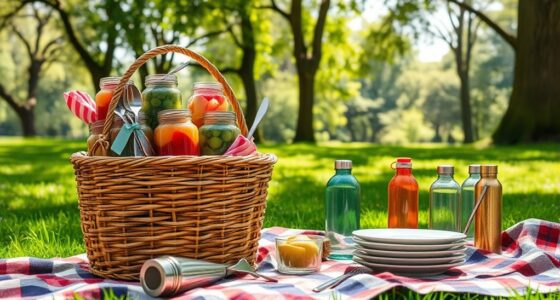To start your home herb garden, choose herbs suited to your climate, space, and cooking habits, like basil, thyme, or mint. Pick containers with drainage and position them where they’ll get 6-8 hours of sunlight daily. Use well-draining soil enriched with organic matter and water consistently to keep roots happy. Regularly check for pests and harvest herbs properly to ensure healthy growth. Explore further tips to keep your garden thriving and flavorful.
Key Takeaways
- Select herbs suited to your climate, space, and cooking habits, considering their sunlight and pest-repelling qualities.
- Choose containers with drainage holes and position them where they receive 6-8 hours of sunlight daily.
- Use well-draining, organic-rich soil, maintain consistent watering, and fertilize appropriately for healthy growth.
- Regularly inspect for pests, harvest herbs in the morning, and dry or store them properly to preserve flavor.
- Practice ongoing plant care, prevent diseases, and address issues promptly to ensure a thriving home herb garden.
Choosing the Right Herbs for Your Space
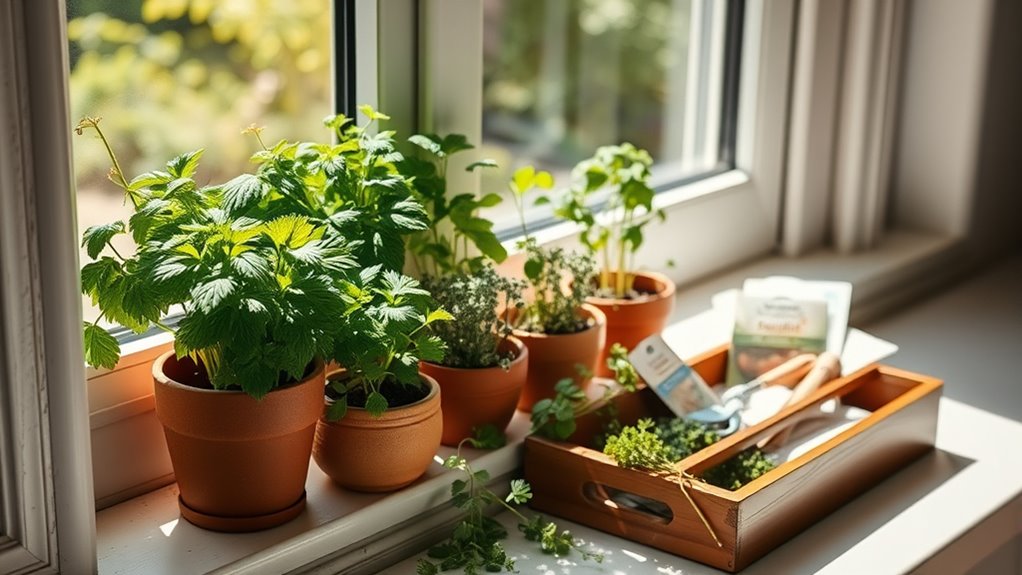
When selecting herbs for your home garden, it’s important to contemplate the amount of sunlight and space available. Your choice depends on the herb flavor profiles you prefer and how much room each herb needs to thrive. For example, basil and cilantro flourish in full sun, while mint prefers partial shade. Consider herbs that also aid in pest prevention, like rosemary and thyme, which naturally repel certain insects. If space is limited, opt for compact varieties or grow herbs in containers to maximize your area. Think about how often you’ll use each herb and select those that match your cooking habits. Choosing the right herbs ensures a thriving garden that offers fresh flavors and helps keep pests at bay naturally. Additionally, understanding plant care requirements can improve the health and productivity of your herbs over time.
Picking the Perfect Containers and Location
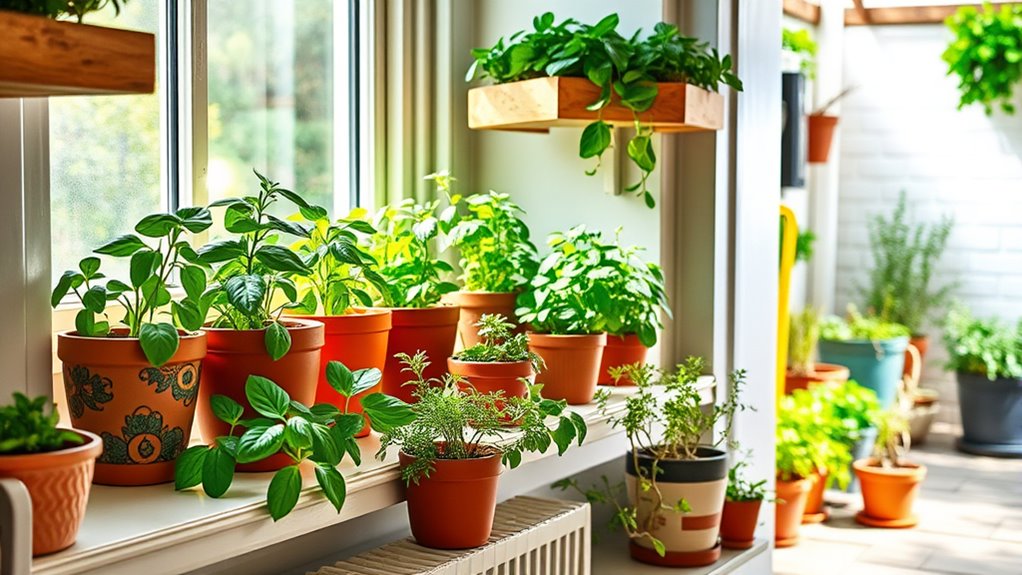
Choosing the right spot and containers is key to herb success. Make sure your plants get plenty of sunlight and good airflow, and pick containers that fit their size and drainage needs. Proper placement and containers help your herbs thrive from the start. Incorporate good lighting to ensure your herbs receive sufficient energy for healthy growth.
Sunlight and Ventilation
Selecting the right containers and location is vital to guarantee your herbs thrive. Make certain your chosen spot receives ample indoor lighting, ideally near a sunny window, to support healthy growth. Herbs need at least 4-6 hours of direct sunlight daily, so monitor the light levels to adjust if necessary. Good air circulation is equally important; it prevents fungal issues and keeps your herbs healthy. Avoid overcrowding your herbs in tight spaces, and consider placing fans nearby if natural airflow is limited. Proper ventilation also helps control humidity, reducing mold risk. By optimizing sunlight exposure and making sure fresh air reaches your herbs, you’ll create an environment that promotes vigorous growth and abundant harvesting.
Size and Drainage Needs
The size of your containers directly impacts your herbs’ growth, so pick those that provide enough space for roots to develop comfortably. An appropriately sized herb garden size ensures healthy plants and better yields. Consider the mature size of each herb to determine container dimensions—bigger herbs need larger pots. Additionally, drainage needs are essential; choose containers with drainage holes to prevent waterlogging, which can cause root rot. Good drainage promotes healthy roots and overall plant vitality. If your containers lack drainage, add stones or gravel at the bottom or drill holes if possible. Placement also matters—select a location where excess water can drain away easily. Properly considering herb garden size and drainage needs sets a strong foundation for a thriving home herb garden. Ensuring that your containers are well-drained also supports the overall soil health and plant vitality.
Understanding Light, Water, and Soil Requirements
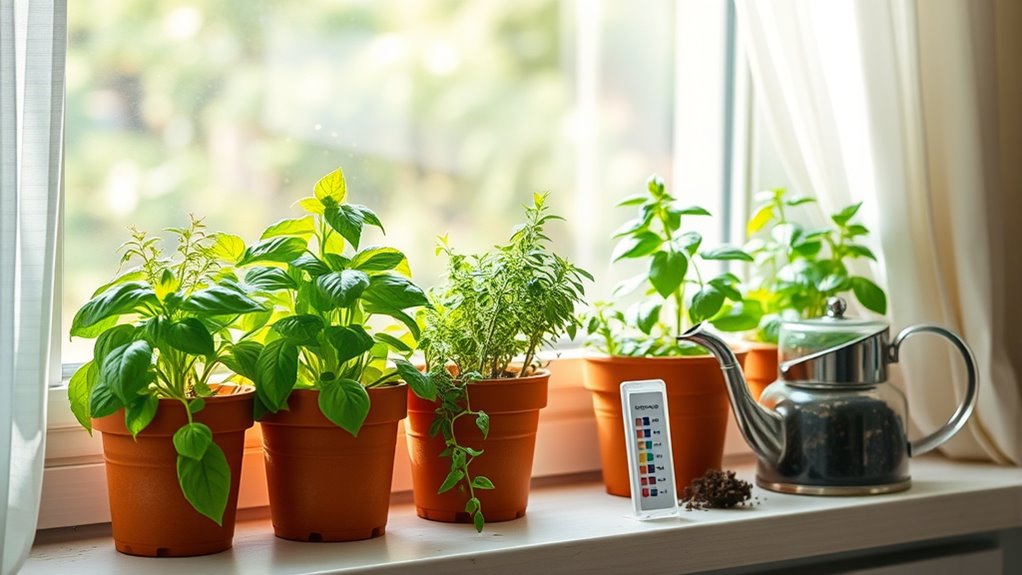
To keep your herbs thriving, you need to understand their light, water, and soil needs. Most herbs prefer plenty of sunlight, but some may do better with less, so pay attention to their specific requirements. Using the right soil mix and watering techniques guarantees your herbs stay healthy and productive. Incorporating a self watering plant pot can help maintain consistent moisture levels, reducing the risk of overwatering or underwatering.
Optimal Sunlight Levels
Understanding the right amount of sunlight is essential for your herb garden’s success. Most herbs thrive with plenty of sunlight, typically requiring 6 to 8 hours of direct sunlight daily. Pay attention to sunlight intensity; if your space gets intense afternoon sun, consider shading solutions like sheer curtains or placing plants a bit further from the window to prevent scorching. Conversely, if your area is too shady, herbs may become leggy and weak. Observe how sunlight moves across your space throughout the day to optimize placement. Adjusting light exposure helps ensure your herbs develop strong flavors and healthy growth. By managing sunlight levels carefully, you create the ideal environment for your herbs to flourish and thrive indoors or outdoors.
Proper Watering Techniques
Proper watering is vital for your herb garden’s health, as overwatering can lead to root rot while underwatering causes plants to wilt and weaken. To maintain ideal growth, you need to balance watering frequency with your herbs’ needs.
Here are key tips:
- Check soil moisture daily and water when the top inch feels dry.
- Ensure proper drainage by using pots with drainage holes to prevent excess water from stagnating.
- Water thoroughly but avoid over-saturating the soil, allowing excess water to escape easily.
Consistent watering helps roots absorb nutrients and prevents stress. Remember, proper drainage is essential to avoid waterlogged roots, so always monitor soil moisture levels and adjust your watering schedule accordingly.
Soil Composition Essentials
A well-balanced soil composition is essential for healthy herb growth, as it determines how well your plants access water, nutrients, and light. Focus on soil fertility by choosing nutrient-rich soil that supports root development and overall health. Achieving the right pH balance is equally important; most herbs thrive in slightly acidic to neutral soil, around pH 6.0 to 7.0. Test your soil regularly and amend it with compost or organic matter to improve fertility and pH levels. Good soil structure ensures proper drainage and aeration, preventing root rot and promoting healthy growth. Additionally, understanding the principles of Ethical Hacking can help you protect your garden’s digital tools and data from cyber threats. Remember, healthy soil acts as the foundation for your herb garden, so investing time in understanding and adjusting its composition will pay off with lush, flavorful herbs.
Planting and Propagating Your Herbs
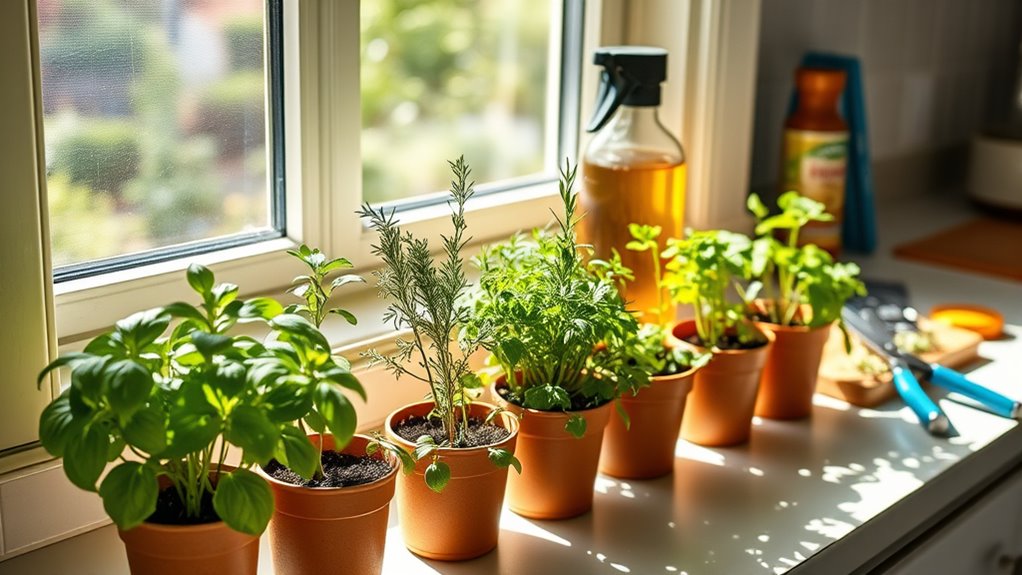
To successfully start planting and propagating your herbs, choose healthy, well-draining soil and containers that provide enough space for roots to grow. Herb propagation methods include seed starting, cuttings, and division. When propagating from cuttings, use clean, sharp tools to minimize disease risk. For organic pest control, introduce beneficial insects like ladybugs or apply homemade solutions such as neem oil to keep pests at bay. Keep soil moist but not waterlogged, ensuring proper drainage. Regularly monitor your herbs for signs of pests or disease, acting promptly using organic methods. Incorporating float mounting textile art techniques can also inspire creative ways to display your herb garden visually and protectively. Proper propagation and organic pest control ensure strong, healthy plants that thrive in your home herb garden. With attention to these details, your herbs will flourish effortlessly.
Caring for and Maintaining Your Herb Garden
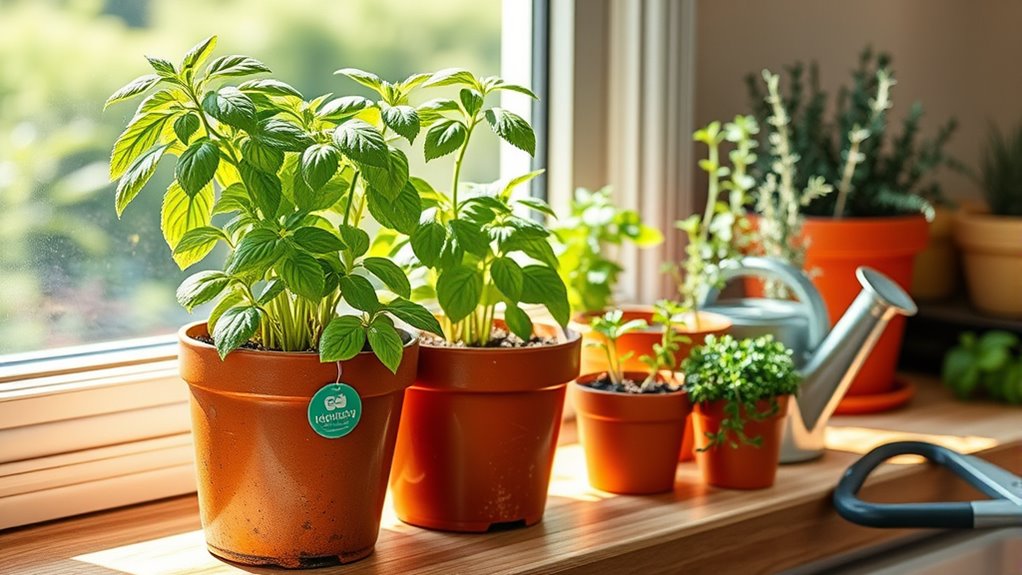
Once your herbs are planted and growing, consistent care is essential to keep them healthy and productive. Regular watering ensures your herbs don’t dry out, but avoid overwatering to prevent root rot. Prune your herbs regularly to promote bushier growth and prevent pests. Pest prevention is key—inspect plants frequently for insects or damage, and use natural remedies like neem oil if needed. To preserve your herbs for future use, consider herb drying—hang small bunches upside down in a cool, dry place with good airflow. This not only extends your harvest but also keeps your herbs flavorful. Additionally, understanding net worth growth hacks can help you make informed financial decisions that support your gardening endeavors. Proper care and maintenance will keep your herb garden thriving, ensuring you enjoy fresh herbs all season long.
Harvesting and Using Your Fresh Herbs
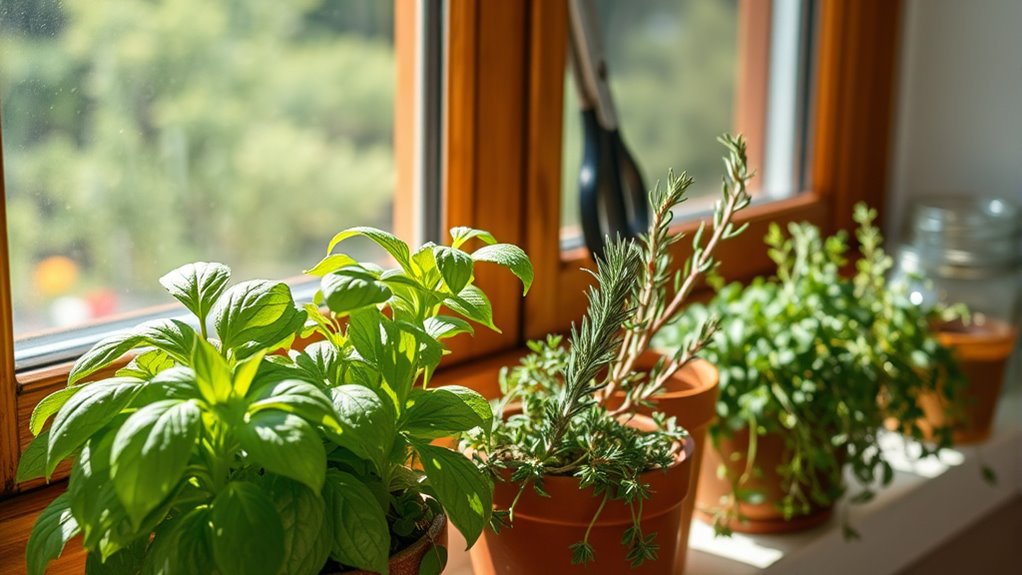
Harvesting your herbs at the right time guarantees you get the freshest, most flavorful results. Pick herbs in the morning after dew evaporates for peak flavor. Use sharp scissors to snip just above a set of leaves, encouraging new growth. To preserve their flavor, consider herb drying by hanging small bunches upside down in a warm, dry area. This method enhances flavor and extends your herb’s shelf life. Once dried, store herbs in airtight containers away from sunlight. When using fresh herbs, add them at the end of cooking to maximize aroma and flavor. For dried herbs, crush them lightly before adding to dishes. Proper harvesting and storage ensure your herbs remain vibrant, flavorful, and ready to elevate your meals. Additionally, understanding the best harvesting practices for herbs can help you maximize their aromatic qualities and overall health.
Troubleshooting Common Herb Garden Problems
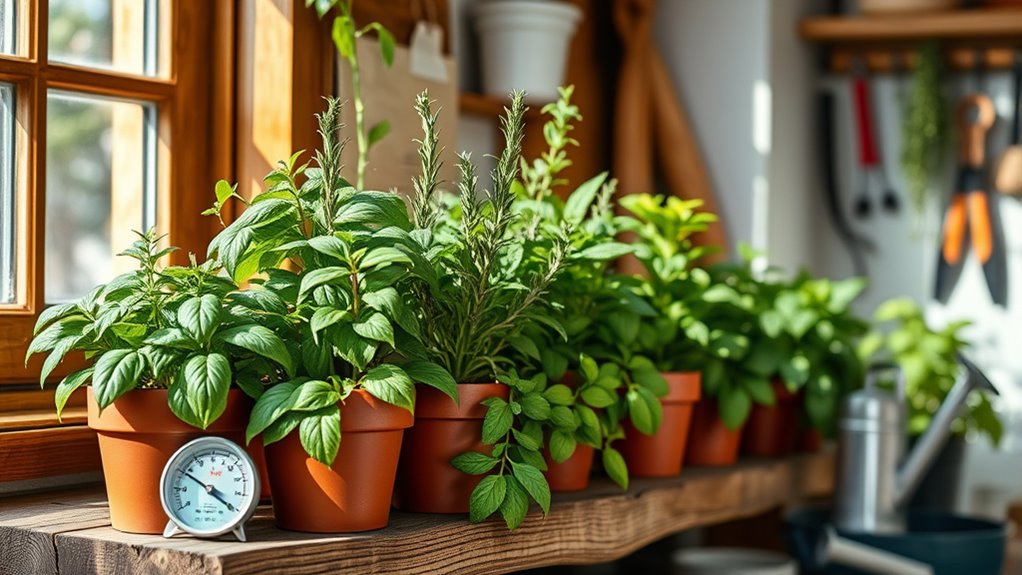
Even with careful harvesting and storage, your herb garden can face problems that affect plant health and flavor. Pests like aphids, spider mites, or whiteflies can quickly damage your herbs. To control pests, inspect your plants regularly and use natural pest control methods, such as neem oil or insecticidal soap. Proper fertilization tips also play a key role; avoid over-fertilizing, which can weaken plants and attract pests. Use a balanced, organic fertilizer to promote healthy growth. Guarantee your herbs receive adequate sunlight, proper watering, and good airflow to prevent diseases and mold. If you notice yellowing or stunted growth, reassess your fertilization routine and pest control measures. Color accuracy can also influence how vibrant and healthy your herbs appear. Address problems early to keep your herb garden thriving and flavorful.
Frequently Asked Questions
Can I Grow Herbs Indoors Without Sunlight?
You can grow herbs indoors without direct sunlight by using indoor lighting solutions like LED grow lights or fluorescent bulbs, which mimic natural light effectively. Choose herb container options with good drainage and appropriate size for your herbs. Place your containers near windows or under your artificial lights, ensuring they get enough light each day. With the right lighting and containers, you’ll successfully cultivate fresh herbs indoors without sunlight.
What Are Natural Pest Control Methods for Herbs?
Ah, natural pest control—because who needs harsh chemicals when your herbs can charm pests away? You can try companion planting, pairing herbs with plants that repel unwanted bugs naturally. Organic sprays, like neem oil or insecticidal soap, also keep pests at bay without harming your greenery. These methods work together, creating a balanced ecosystem where pests are discouraged, and your herbs remain healthy and vibrant.
How Often Should I Fertilize My Herb Garden?
You should fertilize your herb garden about every 4 to 6 weeks, depending on your watering schedule and the fertilizer types you use. During active growth, herbs benefit from balanced, organic fertilizers like compost tea or liquid seaweed. Avoid over-fertilizing, which can cause lush foliage but reduce flavor. Adjust frequency based on plant health, and always water thoroughly before applying fertilizer to make certain of proper absorption.
Are There Herbs That Grow Well Together?
Oh, sure, herbs that grow perfectly together—sounds easy, right? Ironically, successful companion planting is about understanding herb pairing, not just throwing plants in the same bed. You’ll find basil loves tomatoes, and mint can overshadow others, so be strategic. When you plan your herb garden, consider companion planting to improve growth and flavor. It’s like a plant’s version of best friends—pair wisely for a thriving, aromatic garden.
How Do I Prevent Herbs From Flowering Too Early?
To prevent herbs from flowering too early, you should use proper pruning techniques regularly to keep them bushy and healthy. Consistently follow a suitable watering schedule to avoid stress, which can trigger early flowering. Pinch off flower buds as soon as they appear, encouraging the plant to focus on leaf growth instead. By maintaining these practices, your herbs will stay productive longer and yield more flavorful leaves.
Conclusion
By nurturing your herb garden with patience and care, you’ll find that a little attention goes a long way. With each new sprout, you’ll discover the quiet rewards of your efforts, turning simple spaces into lush, fragrant retreats. Remember, even the most delicate herbs thrive when given a gentle touch and the right environment. So, keep tending, and soon you’ll enjoy a bounty of fresh flavors, making every meal a little more magical.


